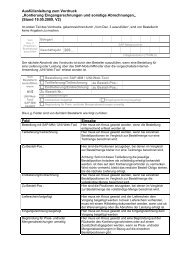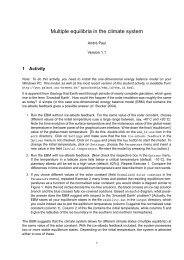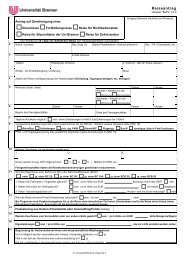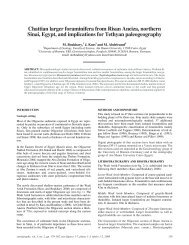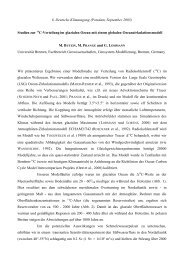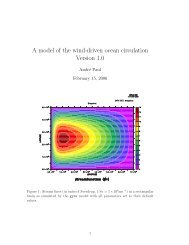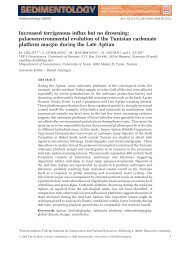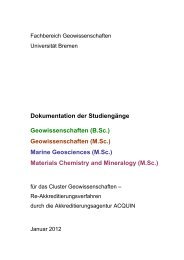Forschung im HLRN-Verbund 2011
Forschung im HLRN-Verbund 2011
Forschung im HLRN-Verbund 2011
- Keine Tags gefunden...
Sie wollen auch ein ePaper? Erhöhen Sie die Reichweite Ihrer Titel.
YUMPU macht aus Druck-PDFs automatisch weboptimierte ePaper, die Google liebt.
146Design of Leading and Trailing Edge Flow ControlNumerical S<strong>im</strong>ulation of Jet Actuation over Swept High Lift AirfoilR. Radespiel, S. Mahmood, Institut fürStrömungsmechanik, Technische UniversitätBraunschweigAbstract• Numerical design of leading and trailing edgeflow control over swept arrangement of high liftairfoil.• The design process involves variation of flowcontrol paramaters along with the opt<strong>im</strong>um locationof the jet actuators and use of the numericallyopt<strong>im</strong>ized flow control settings to performnew exper<strong>im</strong>ents in a wind tunnel.• The Reynolds-averaged Navier-Stokes equationsare computed using DLR TAU Code on 512to 1024 CPU’s.The use of flow control devices like pneumatic jetactuators have been studied quite often in the pastto delay the stalling of an airfoil. One concept isto exploit the interaction between turbulent boundarylayers and longitudinal vortices generated withthe device. The current work addresses the useof jet actuators for leading and trailing edge flowcontrol over the swept arrangement of a high liftairfoil. To date there have been no detailed numericalstudies of the interaction of a longitudinal vortexwith such an arrangement. This is the first t<strong>im</strong>ethat these flow actuators are designed for a swepthigh-lift wing and this task is clearly at the edge ofcurrent computational capabilities.The current status of project covers the numericaldesign of leading edge flow control over theswept airfoil. This activity is of challenging naturedue to difficulties to compute leading edgetype stall. The actuator geometries for actuationat leading edge of swept airfoil have been evaluatedin terms of the variation of spanwise distancebetween the actuators, favorable and unfavorablerotation of the vortices with reference to the sweepangle β and opt<strong>im</strong>um size of the actuator relativeto the boundary layer.The RANS computations for the present activityhave been performed by the DLR TAU code.The numerical efficiency of the DLR TAU codehas been thoroughly tested with success on the<strong>HLRN</strong> parallel computing centre. The DLR TAUcode [1],[2] calculates the three-d<strong>im</strong>ensional compressibleReynolds-averaged Navier-Stokes equationson unstructured or hybrid grids. The codesolves different types of grids ranging from hybridmeshes to fully hexahedral cells. It also providesthe option to accelerate convergence using multigridalgorithm accompanied by low Mach numberpreconditioning.The numerical setup involves the use of 2D gridsto s<strong>im</strong>ulate the infinite swept airfoil for the baseline(no flow control) case by <strong>im</strong>posing spanwise periodicboundary condition along with the sweep angleβ to account for the swept airfoil. For leadingedge flow control cases fully structured hexahedral3D grids composed of 13.0 · 10 6 million grid pointshave been used to s<strong>im</strong>ulate the effect of varyingjet actuator parameters. The flow control cases resolvea single actuator with spanwise periodicity toevaluate the effect of jet actuators. The flow controlused steady state blowing via a special actuationboundary condition available in the solver. The numericalcomputations used 512 to 1024 CPU’s toanalyze the jet actuators. Turbulence transport wass<strong>im</strong>ulated using the Menter’s Shear Stress turbulencemodel [3] as it gives better prediction of max<strong>im</strong>umlift coefficient and proved to be quite usefulin vortical flows [4],[5].The current numerical s<strong>im</strong>ulation with baselineflow predicted leading edge type stall. The flowcontrol s<strong>im</strong>ulations with leading edge actuationproved to be useful in suppressing the leadingedge type stall. Fig. 1 shows numerical representationof the leading edge flow control with favorablerotation resulting in longitudinal vortices overthe upper surface of the swept airfoil. The upperpart of the figure shows the hexahedral grid in theperiodic plane along with the numerical display ofthe favorable logitudinal vortices colored by normalizedu-velocity component using vorticity criteria.The lower part of the figure shows the leadingedge type stall with baseline flow and stall suppressionobtained with the leading edge flow control.The future work of this project involves the numericaldesign of jet actuator for trailing edge flow controlthat is of less complex nature, since the boundarylayer is thicker in this region. These computationswill involve the variation of skew angle, opt<strong>im</strong>umsize relative to the boundary layer and opt<strong>im</strong>umorientation. Final phase of this activity willinclude coupling of Unsteady RANS computationsfor the leading and trailing edge flow control to validatethe results with the exper<strong>im</strong>ents.Ingenieurwissenschaften



